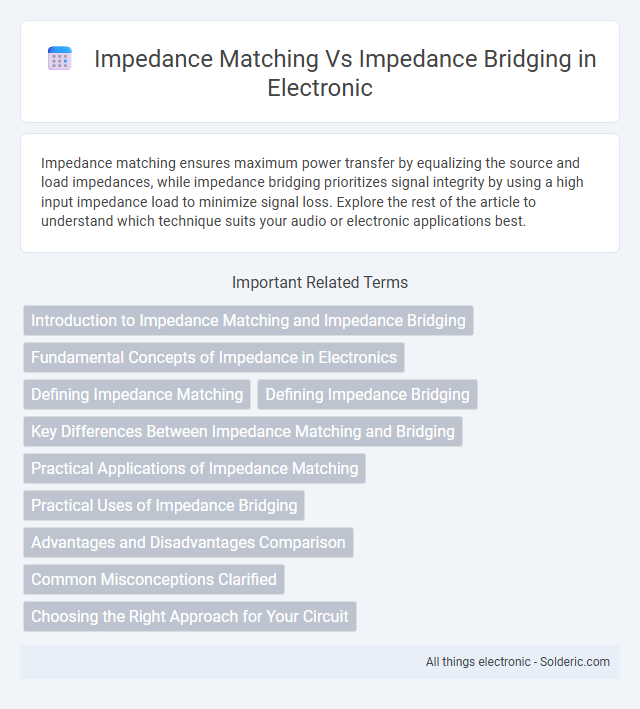Impedance matching ensures maximum power transfer by equalizing the source and load impedances, while impedance bridging prioritizes signal integrity by using a high input impedance load to minimize signal loss. Explore the rest of the article to understand which technique suits your audio or electronic applications best.
Comparison Table
| Feature | Impedance Matching | Impedance Bridging |
|---|---|---|
| Definition | Equalizing source and load impedances for maximum power transfer. | Using a high input impedance to minimize signal load on the source. |
| Goal | Maximize power transfer, minimize reflections in RF circuits. | Maximize voltage transfer, preserve signal integrity in audio and instrumentation. |
| Typical Application | Radio frequency (RF) systems, antennas, transmitters. | Audio amplifiers, sensors, measurement instruments. |
| Load Impedance | Load impedance equals source impedance (ZL = ZS). | Load impedance significantly higher than source impedance (ZL ZS). |
| Power Transfer | Maximized, but voltage is halved at load. | Power not maximized, voltage nearly unchanged. |
| Signal Reflection | Minimized by impedance matching. | Less critical; high input impedance reduces loading. |
| Examples | Coax cable to antenna, 50 O systems. | Guitar pickups to amplifier inputs, oscilloscope probes. |
Introduction to Impedance Matching and Impedance Bridging
Impedance matching involves designing circuits to equalize the source and load impedances, maximizing power transfer and minimizing signal reflections in RF and audio systems. Impedance bridging uses a high input impedance load and a low output impedance source to maximize voltage transfer while minimizing current draw, common in audio and measurement devices. Both techniques optimize signal integrity but serve different purposes: matching prioritizes power efficiency, while bridging prioritizes voltage accuracy.
Fundamental Concepts of Impedance in Electronics
Impedance matching involves designing circuits so that the source and load impedances are equal, maximizing power transfer and minimizing signal reflection in high-frequency electronics. Impedance bridging occurs when the load impedance is significantly higher than the source impedance, ensuring voltage is transferred with minimal current draw, preserving signal integrity in audio and sensor applications. Understanding these fundamental concepts of impedance is crucial for optimizing circuit performance across RF communication, audio engineering, and instrumentation systems.
Defining Impedance Matching
Impedance matching involves designing a circuit so that the source impedance equals the load impedance, maximizing power transfer and minimizing signal reflections. In contrast, impedance bridging connects a high-impedance load to a low-impedance source, prioritizing voltage transfer and signal integrity over power efficiency. Understanding impedance matching helps you optimize your audio or RF equipment for the best performance and signal quality.
Defining Impedance Bridging
Impedance bridging occurs when a device's input impedance is significantly higher than the source's output impedance, typically by a factor of 10 or more, minimizing signal loss and maximizing voltage transfer. This method contrasts with impedance matching, which aims to equalize impedances for maximum power transfer, often used in RF and transmission line applications. Understanding impedance bridging helps you optimize audio and measurement systems where signal integrity and minimal loading are essential.
Key Differences Between Impedance Matching and Bridging
Impedance matching involves adjusting the source and load impedances to be equal, maximizing power transfer and minimizing signal reflection, which is crucial in RF and transmission line applications. Impedance bridging, on the other hand, uses a high input impedance load relative to the source impedance to minimize current draw and voltage drop, preserving signal voltage for accurate measurement or amplification. The primary difference lies in their goals: impedance matching aims for maximum power transfer, whereas impedance bridging emphasizes signal integrity and voltage preservation.
Practical Applications of Impedance Matching
Impedance matching maximizes power transfer by minimizing signal reflection, making it essential in RF communication systems, audio equipment, and antenna design. In contrast, impedance bridging prioritizes voltage transfer with high input impedance and low output impedance, common in audio amplifiers and sensor interfaces. Practical applications favor impedance matching when dealing with transmission lines or when efficiency is critical, such as in radio frequency circuits and high-speed digital signals.
Practical Uses of Impedance Bridging
Impedance bridging is widely used in audio and measurement systems to prevent signal loss and preserve waveform integrity by connecting a high-impedance input device to a low-impedance source. This technique is crucial in scenarios such as connecting microphones to preamplifiers or sensors to data acquisition devices where maintaining the original signal amplitude is essential. Practical implementations of impedance bridging ensure minimal loading effects, enabling accurate signal transfer and optimal performance in professional audio and electronic instrumentation.
Advantages and Disadvantages Comparison
Impedance matching maximizes power transfer by ensuring source and load impedances are equal, but it can reduce signal amplitude and introduce complexity in design. Impedance bridging uses a high input impedance load to minimize signal loss and distortion, making it ideal for voltage-sensitive applications, yet it may cause reflections and power inefficiency if not carefully managed. Matching is preferred in RF and power circuits for efficiency, while bridging excels in audio and sensor systems for preserving signal integrity.
Common Misconceptions Clarified
Impedance matching involves making the source and load impedances equal to maximize power transfer, while impedance bridging uses a high input impedance load to minimize signal loss, ensuring signal integrity rather than power delivery. A common misconception is that impedance matching is always necessary for audio devices, whereas impedance bridging is often preferred to preserve signal fidelity in recording and playback systems. Confusing the two can lead to incorrect equipment connections, resulting in poor audio quality or signal distortion.
Choosing the Right Approach for Your Circuit
Impedance matching maximizes power transfer by ensuring the source and load impedances are equal, which is crucial in RF and audio transmission lines. Impedance bridging prioritizes voltage transfer by connecting a high-impedance source to a low-impedance load, common in audio and instrumentation circuits. Understanding your circuit's functional demands helps you determine whether matching or bridging will optimize signal quality and performance.
impedance matching vs impedance bridging Infographic

 solderic.com
solderic.com